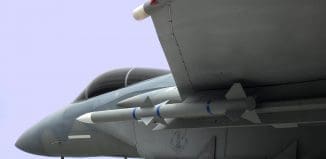US Navy Developing New-Level Lethality
This post is also available in:  עברית (Hebrew)
עברית (Hebrew)
The US Navy is continuing its efforts to innovate and improve capabilities. The Navy in cooperation with Lockheed Martin has fired a high-tech Long Range Anti-Ship Missile (LRASM) from a new launcher that will expand options for the weapon, increase possible deployments and widen the range of potential targets, industry officials said. The Navy added that the deck-mounted firing technology enables LRASM to fire from a much wider range of Navy ships.
The flight test was designed to demonstrate the missile’s ability to conduct an angled launch from a newly designed ship-launch-environment replication. As reported on scout.com, the missile has previously been test-fired from a Navy ship-firing technology called Vertical Launch Systems as a way to provide long range surface-to-surface and surface-to-air offensive firepower. The adaptation of the surface-launcher weapon, which could be operational by the mid-2020s, would use the same missile that fires from a Mk 41 Vertical Launch System and capitalize upon some existing Harpoon-launching technology, Lockheed developers explained.
The LRASM test-firing took place as Lockheed received an $86.5 million contract from the U.S. Navy and Air Force for production. A Lockheed statement said the contract marks the first production award for the air-launched variant of LRASM, and includes 23 missiles and engineering support. “This first production lot of LRASM brings a new level of capability to both the US Air Force and the Navy,” Mike Fleming, LRASM director at Lockheed Martin told defenseworld.net. “LRASM enables our warfighters to prosecute even the most advanced enemy ships,” Fleming added.
With a range of at least 320 nautical kilometers, LRASM is designed to use next-generation guidance technology to help track and eliminate targets such as enemy ships, shallow submarines, drones, aircraft and land-based targets, according to Scott Callaway, Program Director for Advanced Subsonic Cruise Missiles at Lockheed Martin.
Developers say the weapon is particularly well suited for the most advanced adversary weapons systems and most high-threat warfare scenarios such as a “near-peer” type of combat engagements. Advanced threat environments are expected to include enemy forces armed with long-range sensors, electronic warfare, tactics for compromising or jamming GPS signals and a host of additional countermeasures designed to thwart incoming surface and air weapons.
Given that the LRASM weapon is designed for both maritime and air launch, the efforts to build a new launcher are taking place alongside commensurate service efforts to advance the air launch efficacy of the weapon.
Along with advances in electronic warfare, cyber-security and communications, LRASM is designed to bring semi-autonomous targeting capability to a degree that does not yet exist. As a result, some of its guidance and seeker technology is secret, developers have said.
The development of LRASM is consistent with the Navy’s existing “distributed lethality” strategy which seeks to better arm the fleet with long-range precision offensive and defensive fire power. Having longer-range or over-the-horizon ship and air-launched weapons is relevant to the “distributed” portion of the strategy which calls for the fleet to have an ability to disperse as needed. Having an ability to spread out and conduct dis-aggregated operations makes Navy forces less vulnerable to enemy firepower while. At the same time, have long-range precision-strike capability will enable the Navy to hold potential enemies at risk or attack if needed, supplying a justification to the “lethality” part.





























